Need front yard tree recommendation - So Cal
Hi Everyone,
I'm new to the forum and appreciate your feedback! I have a 1926 Tudor style house in Pasadena, CA. At some point (probably in the 80's) a previous owner planted a multi trunk birch tree in the front lawn. It was the only specimen tree in a rather large front lawn so it was quite prominent. With the drought we have had in SCAL the tree died last year so we had it removed and now the front of the house looks pretty bare.
I'm looking for recommendations on what to replace the birch with. I'd like something that is in keeping with the era and style of the house. Most of the 1920's tudors around us have a huge evergreen like an incense cedar on the front lawn. We like the look of an evergreen but realize it would take more than our lifetime to see it reach a decent size.
I'm leaning towards a multi-trunk jacaranda since it can get hot where we are and since the tree is on the lawn, leaf/flower litter wouldn't be too much of a problem. Any thoughts/recommendations would be much appreciated. Thanks!!
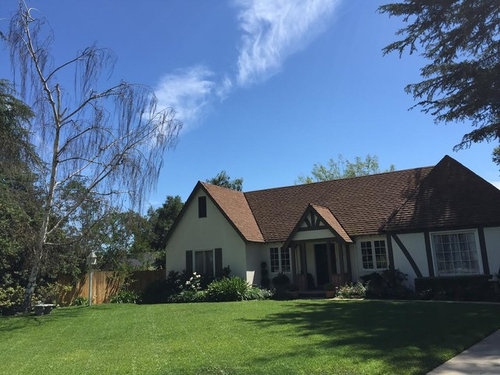
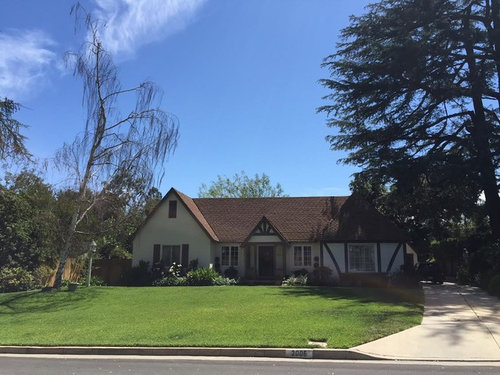
Comments (56)
Diana Patel
Original Author8 years agoGardengal, thanks for the link. I hadn't seen that before and it is very helpful!
Dan. Thanks for the tip on tree size, that will save us a bunch of money. The quote we received for a 36in box jacaranda was $2K planted!
I agree, the Birch was a poor choice, it was too modern for the house and needed a lot of water. Both houses on either side have huge pines in the front yard so I am in agreement that whatever we plant needs to have more width than the previous birch in order to balance the scale. The birch was also planted too far too the left on my opinion so I'm thinking to move the replacement a bit further to the right, but just maybe five feet of so.
wisconsitom
8 years agoHeh, never heard the term "modern" applied to any naturally-occurring plant type before! Not sure I get that. But in any case, you've mentioned Jacaranda and in so far as water will be provided, that could work well. Certainly amazing plants in bloom, and their bloom period is not short. I know next to nothing about Cali horticulture and was surprised to see the Jac mentioned, but I think you know what you're about here.
Incidentally,-and especially if the birch was the non-native Betula pendula type-the native insect bronze birch borer does indeed make it a habit of "finishing off" drought-stressed birch. The native B. papyrifera has decent resistance to this insect pest, but the European B. pendula has none. It continues to puzzle me that it was ever felt necessary to import this decidedly inferior (In our climate/pest regime) plant where perfectly fine native white-barked birch exist. And that's to not even get into the river birch and other more bore-resistant types.
Related Professionals
Piqua Landscape Architects & Landscape Designers · Sand Springs Landscape Architects & Landscape Designers · Matthews Landscape Contractors · Aberdeen Landscape Contractors · Indio Landscape Contractors · Mastic Beach Landscape Contractors · Mendota Heights Landscape Contractors · Munster Landscape Contractors · Cypress Siding & Exteriors · Kalamazoo Decks, Patios & Outdoor Enclosures · Kissimmee Decks, Patios & Outdoor Enclosures · Natick Decks, Patios & Outdoor Enclosures · Northbrook Decks, Patios & Outdoor Enclosures · Waukesha Decks, Patios & Outdoor Enclosures · White Bear Lake Decks, Patios & Outdoor Enclosurestjayars1
8 years agoI agree with Dan. It's tempting to go with the bigger tree for instant gratification but realize it will take longer to adapt to its new location. A smaller tree will catch up to the lager one faster than you think and you will save a good amount of money.
hoovb zone 9 sunset 23
8 years agoConsider Quercus suber, Cork Oak, or the native Q. englemannii. Pasadena = oak trees. A deciduous Magnolia, perhaps. Walk around the nearby Huntington Library and LA Arboretum and look at the trees and see what you like. Many, many, many mature specimens. See examples mature in your region to get a really good idea of what would work--you have those places right in your neighborhood to see excellent examples. Birches are short-lived in So Cal. Jacaranda are a mess and not at all Tudor. They are fabulous in other people's yards.
davidrt28 (zone 7)
8 years agolast modified: 8 years ago"Consider Quercus suber, Cork Oak, or the native Q. englemannii."
Not if you're going to water the lawn.
The native oaks at the Huntington, according to a horticulturalist I spoke to there, are slowly dying off of root rot because they cannot tolerate the watering used to sustain Asian-monsoon understory shrubs like Camellia. One either has a garden that is a California chaparral/garrigue/whatever type landscape, or one does not. You can't mix plant communities requiring differing watering regimes in the same area and expect long-term success. (FWIW, Jacaranda also comes from a summer-wet climate, but is surely more drought and heat tolerant than a white-barked birch! I've seen Jacarandas in southern France that look like they scarcely get additional summer water; but their dry season is shorter, and less dry, than California's.)
Q. suber is surely more tolerant of summer water (they grow, more or less, in the US SE) but is evergreen and "dark" looking, much like Cedrus libani. The OP didn't want that. Being more closely related to oaks from Arizona, Q. englemannii could more somewhat tolerant of summer water, but I wouldn't want to take my chances. Some western trees and shrubs will grow on the east coast, or in the southeast, for years, until a wet spell finishes them off. In other words, you don't want a planting where "oops, I left the sprinklers on for too long" means a huge plant is going to drop dead. Also, just a personal observation that the sclerophyllous oaks of Europe, at least, are all quite ugly when young, and take years to assume the picturesque forms seen in rural landscapes. I don't know of the degree to which that specifically applies to the various California species, but for example, this isn't something that would warm my heart to look at every morning for a decade! (see the lower pictures of the crated specimen for sale)
BTW, nice looking house Diana! I assume from your last name you or your spouse are Gujarati? I wouldn't rule out a tree from that area of India, but it might be harder to find in the nursery trade of SoCal.
wisconsitom
8 years agoOf course you're right, Davidrt, that the watering regime, more than any other factor, will dictate what can work here. My initial response would have been something along the lines of one of the evergreen Cali-native oaks. But OP's yard looks irrigated. One final comment-yes, those oaks in your link do look as though they may have an ugly duckling phase, but surely no worse than watching an utterly inappropriate birch die out over the years!
And final finally-maybe I'm wrong, but it would seem that yards with irrigated turf and all that goes with that will surely become an anachronism in Cali, no?
edlincoln
8 years agolast modified: 8 years agoBlue Oak (Quercus douglasii) is another tree that can't survive in a watered lawn...that's why I started by asking if you were going to water it. That totally changes the options. ken_adrian:
This isn't like a habitable planet. This is Southern California, a lifeless wasteland not meant for human habitation where you have to dump water on almost anything to keep it alive.
What about California Bay Laurel (Umbellularia californica)?
davidrt28 (zone 7)
8 years agolast modified: 8 years ago"And final finally-maybe I'm wrong, but it would seem that yards with
irrigated turf and all that goes with that will surely become an
anachronism in Cali, no?"That's the elephant in the room I didn't even want to touch. But I suspect Pasadena recommends Jacaranda because it's quite dry-tolerant for a tree that doesn't come from a Mediterranean climate. They will likely get more mileage out of it per unit supplemental water than many other trees that could be planted there. And, not to mention, they are gorgeous when blooming and reasonably good looking the rest of the year.
davidrt28 (zone 7)
8 years agolast modified: 8 years ago"Southern California, a lifeless wasteland"
I have to take issue because I was lucky to visit California when they were having a nice, wet wet season, and that wasn't my impression at all. Even in Southern California though it isn't as lush looking as northern California, some parts of which practically looked like "western British Isles - with a lot more sunshine" at that time. The grasslands of upper Sonoma County were lush and green, that gray moss was hanging from evergreen oaks, etc. And of course that was after driving out of the redwood forests... For example on the drive into a canyon near Ventura to visit Australian Native Plants Nursery, you could see how the higher elevations that picked up more rain from orographic lift were greener than the bottom of the valley.
This scene is a good example: https://goo.gl/maps/kaSDQWjP93D2
Those hills aren't a lifeless wasteland!
gardengal48 (PNW Z8/9)
8 years ago"This isn't like a habitable planet. This is Southern California, a
lifeless wasteland not meant for human habitation where you have to dump
water on almost anything t keep it alive."Seriously?? Have you ever been to SoCal?? Even with an extended drought, SoCal is a pretty lush environment, although 'lush' in California terms may not be the same as lush in the Northeast (or Northwest, for that matter). Because of family in the area, I visit SoCal often and cannot recall ever having a sense of it being a "lifeless wasteland" - quite the opposite!
And this drought and responses to it are not new. Waterwise gardening suggestions, specifically the California Friendly Gardening program, have been in place for at least a decade and many of the gardens created under these programs are stunningly beautiful with a wide variety of plants and flowers that have their own sense of lushness.
btw, if the OP favors the jacaranda, acknowledging that it IS a bit messy (but this is not necessarily a hindrance in a front lawn as long as located at a decent distance from the driveway), it should be noted that jacs are recommended on the bewaterwise.com website.
edlincoln
8 years agoI intended my comment to be humorous. People seem to be a bit sensitive.
I do like the recommendation of: bewaterwise.comEmbothrium
8 years agolast modified: 8 years agoExisting native oaks are harmed by irrigated landscapes being installed around them. Young California oaks coming out of irrigated nursery production and being planted into gardens are a different story.
Yes, the birch was Betula pendula - a cold climate species native to Europe and therefore, if anything far more thematically compatible with a Tudor house than many trees common to southern California neighborhoods - including and especially tropical ones like jacarandas! In fact maybe the ill-fated tree got put there in the first place because a previous owner was trying to conform to the context established by the style of the house. So if you are now going to follow suit you will choose something else that looks northern European - rather than South American.
wisconsitom
8 years agoThat could be, Embo, but my comment was that B. papyrifera-if one must have a white-barked birch-is preeminently a superior plant here in N. America, even including SoCal. I could tell upon first look that this was a pendula.
Ed, I got ya. Now as far as central to southern Cali horticulture, I'd have to say that some of the offerings available and suitable for that climate just in the succulents alone lead me to think perhaps some of the finest gardens I've ever seen are from that region. And hugely appropriate for the climate too, I might add. I've never been, so this is all about magazine photo spreads, but my socks have been knocked off, my mind blown, by some of what I saw.
I'd personally never use the alleged architectural imperatives as an excuse to use wholely inappropriate (for the climate) plant types in any design work that I would be doing. Talk about a dead-end. Not that OP planted that tree.
davidrt28 (zone 7)
8 years agolast modified: 8 years agoEmbo,
Obviously you have more experience with western arboriculture than I do, but I'm skeptical of your claim that the age of the planting is somehow going to magically exempt California native plants from problems with summer water. You are in Seattle where summers and corresponding soil temps. are much cooler than Pasadena. The roots of such plants simply haven't evolved to defend themselves from the pathogens that thrive in warm, wet soil. Age of plant shouldn't make a difference. Do you have a link to someone like, say Las Pilitas nursery saying that such plantings are known to succeed for decades? Obviously, the oaks at the Huntington lasted for a long time with the less than ideal (to them) watering regime. So I don't think this is something that can be evaluated by the typical academic study time-frame.
Anyhow the question is academic in this case because I really doubt it's what Diana wants.
Embothrium
8 years agolast modified: 8 years agoI'm not talking about what happens here, I'm talking about what the experience has been in California. It would not even be possible to produce California native oaks in irrigated nurseries if they can't ever take being regularly watered.
Paper birch is a cold climate indicator tree that does not even occur wild near sea level in my area until you reach northwest WA state, north of Everett. I do not remember seeing this in southern California, if ever there was a tree I wouldn't expect to survive the climate and soils of that area this is it.
I am not sure the birch shown on this thread was an example of it but the common weeping birch of hot climates here in the West is 'Laciniata'. This actually does quite well on watered lawns in the interior Northwest, where it makes spectacular specimens of much higher quality than the same selection usually produces here on the wet side of the mountains.
Diana Patel thanked Embothriumedlincoln
8 years agoObviously they can take being watered. The question is whether they can take being watered to the extent needed to keep grass nice and green...I assumed they watered them less in nurseries. After all, there are nurseries somewhere that grow cactus.
The answer may be different for different species. I'm skeptical about claims that any rule applies to all species. I know the website I read about Blue Oaks on warned not to plant them in irrigated lawns.Diana Patel thanked edlincolndavidrt28 (zone 7)
8 years agolast modified: 8 years ago"It would not even be possible to produce California native oaks in
irrigated nurseries if they can't ever take being regularly watered."Yeah but that's a bit of a canard. If that's your justification it's a poor one. Container production, in particular, just doesn't expose things to the soil environments that cause these kind of problems. It's actually a bit of a paradox that it doesn't, but believe me, it doesn't.
Anyhow, I don't really have a dog in the fight because I'm not in SoCal. I advise anyone who is to first confirm what Embothrium says with a local expert. Again the question isn't can they survive watering for 1, 3, 5 or even 10 years. It's a question of decades.
Diana Patel thanked davidrt28 (zone 7)Embothrium
8 years agolast modified: 8 years agoThe idea that young stock that has had regular watering from the start does not have the same problems as mature native oak trees being subjected to a changed environment does not start with me, by any means. If it were me I would definitely not pass on a native oak merely because this is a watered setting.
On a related subject the planting site should be checked to see if there is oak root fungus present - without knowing one way or the other this could even be what killed the birch. And if it has not already been done the stump of the birch should be ground out or removed entirely. If Armillaria is present on the site it would be unwise to buy and install a large and expensive replacement tree - of any kind - without making some kind of serious effort to ameliorate the infestation.
Diana Patel thanked Embothriumdavidrt28 (zone 7)
8 years ago"without making some kind of serious effort to ameliorate the infestation."
I'm just curious, how can that even be done? It didn't know any soil sterilization protocol could remove such pathogens.
Diana Patel thanked davidrt28 (zone 7)Diana Patel
Original Author8 years agoWisconsitom, I used the term "modern" because in my neighborhood there seemed to be a theme in the 80's where new builds and landscape remodels used birch trees. So you could almost tell what decade the work was done by the landscaping. Our house was remodeled in the 80's so I'm guessing that's when our birch was planted.
I was leaning towards the jacaranda even though I realize it's not really a Tudor type tree for a couple of reasons. We had a jacaranda in the back yard that was gorgeous and we never watered it so I know how drought tolerant they can be. Unfortunately, it had been planted where the leaves and flowers fell right in to the pool and onto the back patio. I would have moved it to the front if I could have but it was too big.
My concern/question about putting a jacaranda in the front is whether watering the lawn may be too much water for it and whether the leaf and flower littler might choke out the lawn.
I like the look of the Engelmann Oak, however, I'm hesitant about Oaks in general because where we live, there are all kinds of regulations about what you can do with and around an Oak tree. It takes pretty much an act of congress to remove one or even build/landscape around them. Plus, I thought they also don't like too much water?
edlincoln
8 years agolast modified: 8 years agoI know what you mean by modern. In my area, Yew hedges and foundation platings look "dated" because that was the style some decades ago. Gingko look modern because they became popular more recently. I've actually noticed a lot of birches planted lately myself.
There are many species of oak, plenty of which wouldn't mind a watered lawn at all. (eg black oak, swamp white oak). It's the California native oaks you may have to worry about.
Personally, regulations preventing people from cutting down oaks would be a huge motivator for me to plant one. I take pride in the trees they plant, I like to imagine them outliving me. The idea the next owner could lop them down to make room for more lawn always makes me sad. Regulations to prevent that would make me feel that I was leaving a legacy.
Grass is really an aggressive weed. It shoud be fine with leaves and litter falling on it. Out East we get lots of leaf litter on grass and it survives fine.
Diana Patel thanked edlincolnDiana Patel
Original Author8 years ago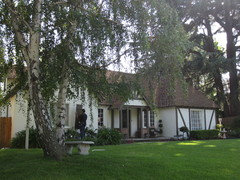
For reference, here's a photo of the now deceased Birch when it was in it's prime. Does this help confirm what type it was?
We did have the stump ground out and are not in a hurry to replace it just in case there was something hanging out in the soil.
Embothrium, that's a good point you made about birches being European, I hadn't really thought about that, I may now have to keep them on my list to consider. I agree, the jacaranda is tropical looking but I confess I'm partial to those gorgeous blue flowers. In the town next door to us (Pasadena) there are streets lined with jacarandas and when they are all in full bloom it is breath taking.
So an Oak, if they can take the lawn watering might be an option also. I like the idea of knowing it would be there for generations. I was just afraid it would take a long time to get to a good size and look like a Charlie Brown Christmas tree for most of my lifetime. Are there fast growing Oaks?
Diana Patel
Original Author8 years agoBTW, davidrt28, yes, my husband's family is Gujarati, although hubby is actually from Detroit! I hadn't even thought about trees native to India what an awesome idea!
edlincoln
8 years agoSpeed is relative. The most dessert hardy oaks grow slowly. Some oaks grow a bit faster. I have no personal experience with these varieties, but supposedly Mexican White Oak, Laurel Oak, and Willow Oak are fairly fast. You'll have to check what varieties are OK with lawn irrigation.
If you want a jacaranda, I have no problem with that. I don't think anyone on this thread has raised an objection to it.Embothrium
8 years agolast modified: 8 years agoEngelmann oak is a relict species left from a time when the local
climate was moist, should like being on the lawn. It has nice, small
blue leaves. Otherwise, if you wanted a high branching shade tree a
valley oak should be a good choice. This has a tall, vase-like crown for
a long time and appears to develop rapidly under suitable conditions - a
sort of western analog to American elm.For that matter I don't know that any of the California native oaks would necessarily require a dry soil at all. The one species that extends all the way up here as a native tree - Garry oak - only needs a situation where other trees do not overtake it (it is slow growing). Otherwise it is seen growing in places ranging from 13 in. in rainfall to 103 in., from dry rocky outcroppings to swamps - anywhere it can keep a place in the sun for an indefinite period.
Oak retention regulations presumably are aimed at preventing all the
existing, mature native oaks from being cleared off - and may not apply
to new plantings at all.Your birch was a typical Betula pendula and not the 'Laciniata'. I didn't think it had the crown outline of the cultivar.
Jacaranda mimosaefolia is native to Argentina and Bolivia. The
genus in general - there are 30-45 species - is characteristic of wet
rain forests of tropical America. In cultivation these trees appreciate
moist, fertile soils that drain well.Diana Patel thanked Embothriumdavidrt28 (zone 7)
8 years agolast modified: 8 years ago"My concern/question about putting a jacaranda in the front is whether watering the lawn may be too much water" Not likely, this is a typical climate where it grows - probably the drier part of the range:
Córdoba, Argentina - Wikipedia, the free encyclopedia
About 6 inches of rain at the height of summer. Diana will probably not use that much water on her lawn.
The notion, in this case, that the plantings somehow have to match the style of the house is, in my opinion, utterly ludicrous. One of the great things about Southern California is the crazily eclectic mix of architectural styles with subtropical plants. Your "tudor" isn't going to look authentically English anyhow when you have over 3000 hours of sunlight a year, whilst London has 1500.* What are you going to do, stretch a giant shade cloth over your house so that the lighting is always appropriately somber!? It's tudoresque anyhow, not authentically Tudor. No one would think this is actually a half-timbered house in the York countryside. (even tho it is adorable, and I find it architecturally admirable!) I do object to say, hedge fund barons in Connecticut building "mansions" that strive to look like authentic Colonial or 1920s Colonial Revival homes, then landscape them in the idiotic, overly busy,
"pompous northeastern landscape architect trying to run up his bill with layers of fancy shrubs" style. When those stately homes were never authentically landscaped that way, whether in the UK or the US East Coast. That's quite different. Should this Dutch-influenced building in Windhoek not have a palm in front of it, because that palm tree would not be found in the Netherlands?http://www.jordanibb.com/windhoek.html
Insanity! Once the historical style isn't even in a climate that matches where that style would originally be found, all rules are off. Other than the universal rules of good design...
* - and the sun is much stronger in LA, anyhow, even when shining in both places.
davidrt28 (zone 7)
8 years agoEmbo - what's your feeling about Maytenus boaria as a recommendation? I think a weeper could look good in that spot.
Diana Patel thanked davidrt28 (zone 7)Embothrium
8 years agolast modified: 8 years agoChinese elm might work better for that effect - it's apparently too hot or otherwise unsuitable for Mayten in most of southern California.
If I lived there and I had decided to go with a Trees of India theme I might track down an Indian horse chestnut and plant that. It grows with the Deodar cedar in the wild so that would be a naturalistic pairing with the cedar (to the right of the house in the views shown), plus it is a very fine tree on its own. And is known to grow in LA, where there was one over 42 ft. tall in 1993*. However it being an Aesculus it has a sparse, knobbly winter aspect that might not appeal in this instance - and it drops large seeds which could be a deal breaker for quite a few people trying to maintain a lawn in the same area. There is also the problem of finding one in commerce at this time - perhaps nobody is listing it at the moment. Probably not in specimen sizes, at any rate.
Some other Indian flowering trees that are being grown in southern California are
Acrocarpus fraxinifolius
Bauhinia variegata
Melia azedarach
Pittosporum napaulense
I picked these out of Walker, Brigham, Ornamental Trees for Mediterranean Climates - The Trees of San Diego (2005, San Diego Horticultural Society) - and where I noticed regarding the native oak watering question it says under Quercus agrifolia
In cultivation, it can grow quickly if given regular deep watering and a fast-draining soil, but will grow more slowly in heavy soil and drought
and under Q. engelmannii it says
Like the Coast Live Oak, the Mesa Oak grows best with occasional deep waterings
and also goes on to say (notice, again, the emphasis is on the introduction of irrigation to the root zones of previously wild-living trees of some age)
Because of their susceptibility to root rot, it is important to keep water away from the base of any of our native oaks, and in particular to avoid overwatering around any existing old tree. Preserving the natural layer of leaf litter underneath mature trees is important for their health as well. Old, established native oak trees are frequently endangered by intrusive human activity, sometimes with tragic results. Even a tree that has been healthy for centuries can die within 10-20 years if mistreated
*Jacobson, North American Landscape Trees, (1996, Ten Speed Press, Berkeley), where the tree is characterized thus:
Compared to the common A. hippocastanum, this species is a cold-tender, refined, glossy, connoisseur's tree, it flowers a month or so later; the leaves stay green very late into fall (mid-November in Seattle)
Diana Patel thanked Embothriumparker25mv
8 years agolast modified: 8 years agoAnother uncommon but attractive species is the yellow cotton tree (Cochlospermum regium). The double-flowering ornamental cultivar does not produce any annoying seeds.
davidrt28 (zone 7)
8 years agolast modified: 8 years agoThe Indian Horsechestnut is a good suggestion. I've seen the ones at Kew and they are spectacular in bloom. Alas, very much the sort of plant that is hard to find these days in the US.
Embothrium
8 years agolast modified: 8 years agoHas been listed in the past by Colvos Creek and Forestfarm. Mike would have been able to offer it repeatedly because of it being present in local publicly accessible collections (44' tall in the Carl English Garden at the government locks in Seattle ca. 2005), with it merely being necessary to gather the fallen fruits while still fresh.
davidrt28 (zone 7)
8 years agolast modified: 8 years agoI don't mean to digress into this, but when I look at old Forestfarm catalogs, I wonder if they are trying as hard to find obscure stuff like that as they used to. As you know the Prags have stepped aside mostly, at this point. OTOH, they still are getting liners of stuff that would be cutting edge here on this side of the country and I would otherwise have difficulty locating. For example, Mahonia 'Buckland' which was on my last order with them in the fall. Maybe they just have an internal policy of not prioritizing anything they've offered before; from the POV of their institutional buyers who I presume are some of their most steadfast, profitable customers*, that kind of makes sense. (* - I often see their tags at the University of Delaware)
floral_uk z.8/9 SW UK
8 years agolast modified: 8 years agoI have nothing to contribute re the OP's question but I can provide a photo of Aesculus indica growing in my local park.
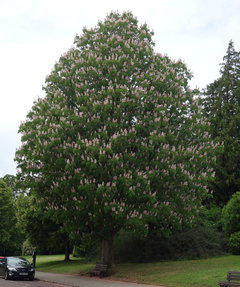
And A hippocastanum for comparison in another local park.
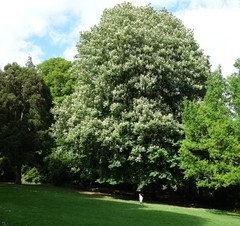
And a couple of red ones for good measure. Also local.

A indica taken June 26th 2015. The other two species taken 24th May, so a month earlier, as Embothrium indicated.
A indica blossom.

Embothrium
8 years agolast modified: 8 years agowhen I look at old Forestfarm catalogs, I wonder if they are trying as hard to find obscure stuff like that as they used to
Sales of woody plants are down at Forestfarm as elsewhere. Colvos Creek closed after decades of operation due to this same recent falling off. One local multi-million dollar independent garden center has no dedicated display of broad-leaved trees at all at this time. The Seattle arboretum support organization has actually discontinued its annual spring sale, previously the biggest one in the area. I noticed while attending it and similar events during the last few years that the big draw was the novelty tomato plant vendor - vegetable starts, fruiting bushes, flowering annuals, other Victory Garden stuff is what the hobby gardening public is looking for these days, more than any other single category. In keeping with this when a mail order edible plant specialist operating in this State went online some years ago they had to build a big new cold storage building to accommodate the resulting surge in sales.
Meanwhile landscape architects and landscape contractors report that the constant request now is for plants that do not require any attention.
Such things are not what a home owning public interested in collector trees and shrubs does.
Diana Patel
Original Author8 years agoThank you everyone, the information provided has been extremely educational and helpful. You are quiet a knowledgeable group! Thanks much!
davidrt28 (zone 7)
8 years agolast modified: 8 years agoEmbothrium - yeah, we can only hope this is a lull and not a cliff LOL.
Floral_UK thanks for the awesome pics. It's perhaps debatable from your pictures alone, but my thinking is that when one sees them in person, Aesculus indica is the leader in showiness. Your closeup captures the alluring quality it has. The flowers are somehow just "meatier" than other horsechestnuts.
davidrt28 (zone 7)
8 years agoYou're welcome Diana, and thank you. We like it when an "OP" stays with the thread and appreciates our suggestions. Good luck with your landscaping and keep us updated!
Embothrium
8 years agolast modified: 8 years agoI forgot to post earlier the San Diego book mentions the jacaranda being able to take some drought.
wisconsitom
8 years agoJust a few additional comments: Again, it was obvious this was a Betula pendula from the moment I opened this thread. Not a major point by any means, but I guess somebody in my position has seen a lot of birch. And Diana, I don't know if you meant this, but you "agreed" with Embo that "birch are European". That's a puzzling statement when read by this person, who happens to own many acres where the native Betula papyrifera is one of the three most common species, the other two being Pinus strobus and Thuja occidentalis. This is a "woods", not a nursery. Forest fires in the 1930s "planted" these species.
Finally, I only wish you success and yes, some truly fine ideas have now surfaced. I'm just glad there's people interested in re-treeing their yards, period.
Oh, and there's a lag effect in tree availability in the nursery trade. A few years ago, the market tanked and nurseries with lots of trees ready for sale couldn't get rid of them as the housing market stalled. Along with that was a strong trend not to start new liners. We are now in the trough of tree availability due to that fact, even as demand has increased nationally. Ever it has been so.
Diana Patel
Original Author8 years agoFloral_uk, may I ask what part of the UK you are from? I'm originally from Hampshire and was just there visiting family last Sept. My favorite memory of the area is the sound of the breeze softly rustling the tree leaves and the Owls hooting in the background. So relaxing!
floral_uk z.8/9 SW UK
8 years agoHi Diana
I lived in Hampshire for most of my childhood ages 5 - 18. Now I'm in Somerset. Whereabouts did you live in Hants?
Diana Patel
Original Author8 years agoI was born in New Milton, Hampshire, but my family moved to California when I was about 5. We still own the family home in New Milton and all the extended family still live in and around the area. None of them were brave enough to follow my parents out to California!
floral_uk z.8/9 SW UK
8 years agoNot a million miles from where I lived from 5 to 14, on the edge of the New Forest. I was in Ca last Summer. We had a good time but gosh did I miss green.
davidrt28 (zone 7)
8 years agolast modified: 8 years ago"I was in Ca last Summer. We had a good time but gosh did I miss green."
Well, you see, that's the problem. You should visit places like Southern California and the Southwest in the winter, not in the summer. Of course it depends on what kind of a wet season they are having.* And the Southwest is almost always dry at low elevations, but at least you aren't going to have to worry about dying of heat exhaustion in winter. At high elevation? Flagstaff was cool in January (not really cold to me, I was only there during the day) but there are plenty of trees around.
* and what kind of conditions you are looking for. Maybe for Brits, "anywhere warm enough to lounge by a pool" is a lead requirement. I get plenty of heat here in summer, so my vacation code is "anywhere I won't break a sweat".
floral_uk z.8/9 SW UK
8 years agoI would love to have visited in Winter but my job doesn't allow it, although the drought had been so prolonged I'm not sure that the Winter would have looked much lusher. Certainly there were a lot of very unhappy-looking trees around which had clearly been thirsty for a long time.
Personally, I can't stand sunbathing. I get bored and sweaty in a few minutes. A pool is for swimming in, not sitting by, in by book.
davidrt28 (zone 7)
8 years agolast modified: 8 years agoUnderstandable floral. I just find it somewhat mystifying that people visit certain parts of the US in the hot season when the rest of the year is so much nicer. Even when there's no factor keeping them locked into the summer. I loved San Antonio Texas's Riverwalk in winter: I'm sure I wouldn't have loved it in summer when the average high is almost 100F. This is actually true of my parents. Their mentality seems to be you'd only go somewhere in winter that is tropical warm, like the Bahamas. I once suggested they visit central TX but only in winter (because it's one of the only places in the US they haven't been) - even spring can be very hot there - and my Mom said "we don't mind the heat". Maybe it's an old people thing LOL.
Embothrium
8 years agoYes, the grass on the foothills was brown during winter last time I was in California.
wisconsitom
8 years agoSaw a funny old circa 1960 promo video on TCM for Hollywood. Leads me to believe it is that area's man-made flora if you will that is most intriguing, at least to the novice, which I most decidedly am when it comes to the plantlife of SoCal. All the big crazy yuccas and whatnot, numerous succulent genera, the liberal use of groundcovers, the palms of course, the mostly non-indigenous conifers, all led to what was-in this video of some decades back-a most beautiful and interesting effect. It may be that just as the Great plains prairie (where it still exists) almost could be said to take practice to learn to appreciate, so too with the native scrub of the S. Cal. region. That can surely happen. But for instant gratification, this unintentionally humorous old bit of film was chock-full of horticultural eye candy.
ingrid_vc zone 10 San Diego County
8 months agoI apologize if it's been mentioned before, but what about crape myrtles? You have blooms for several months in the summer, leaf color in the autumn and lovely bare branches in the winter. They definitely are not water hogs, will never have huge roots that can bug you ten years from now, and mine have never had pests or diseases. There are several pretty colors to choose from (I favor the lavenders and purples) and should with luck never give you a problem to deal with.
davidrt28 (zone 7)
8 months agoJust for your awareness, the creator of this thread hasn't posted anything in over 7 years.




















gardengal48 (PNW Z8/9)